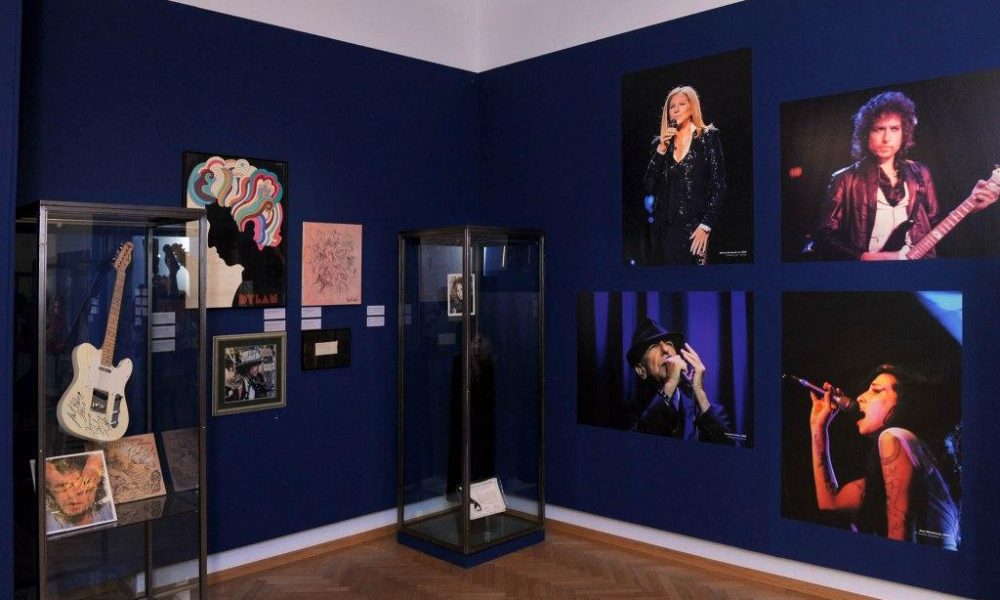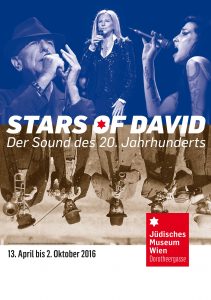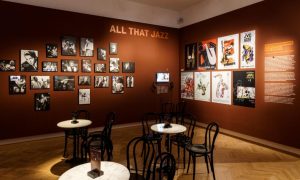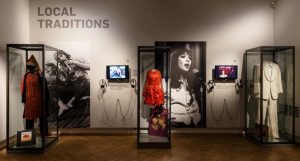Stars of David. The Sound of the 20th Century – Exhibition in the Jewish Museum Vienna

Willkommen. Bienvenu. Welcome.
This famous song from the musical Cabaret greets visitors to the current exhibition “Stars of David” in the Jewish Museum in Vienna’s Dorotheergasse. I dare say that anyone who has the slightest interest in popular music of the last 100 years is truly welcome and in good hands at this exhibition. It’s not dry theory, but rather stirring audio examples, live concert recordings and original exhibits that will thrill and often surprise visitors.
Sound of the 20th century and the Jewish Museum – how do they go together?
There’s a clear answer to this question: perfectly.
To name but a few examples: Did you know that one of the world’s most famous Christmas songs, namely “White Christmas,” was composed by Irving Berlin, the son of Jewish immigrants from Belarus? Or that the Jewish composer duo Leiber & Stoller made non-Jewish musicians such as Elvis Presley famous with many of their songs, such as “Jailhouse Rock”? Or that numerous famous artists such as Barbra Streisand, Bob Dylan, Amy Winehouse and Leonard Cohen, as well as music groups from all genres, such as Kiss, the Ramones and the Beastie Boys have professed their Jewish faith?
You’d be astonished by how many hits, musicals, film scores, composers, lyricists and musicians you’ll encounter at the exhibition. Jewish musicians mark the music business of the 20th and 21st centuries and made a significant contribution to entertainment culture. “Stars of David” thematises various genres, portrays important exponents and goes back to the time of the monarchy, where the roots of this (music) history can be found.
From musicals to film music, all the way to jazz, rock and pop
At the beginning of the 20th century, there was on the one hand a separate and on the other a reciprocal influence in popular music in America and Europe. While operettas and revues became ever more popular in Vienna and Paris, above all Vaudeville stages and musicals, and later film versions of musicals, established themselves on Broadway. Masterworks came about, such as West Side Story (by Leonard Bernstein and Stephen Sondheim) and Singing in the Rain (by Arthur Freed). Yet there was also a stimulating exchange: European immigrants brought their musical traditions to America and American music found its way into European popular culture. Due to the immigration of many Jewish artists from Europe during the National Socialist era, the stronghold of music relocated to America.
Alongside it a lively jazz scene arose, a new interplay between black and white musicians, who attempted to break out of their dismal social environment. Racial segregation was ruptured – for the first time, black and white jazz musicians stood alongside one another onstage. Jazz musicians of Jewish heritage, such as Artie Shaw, Benny Goodman and Stan Getz, were stars of the jazz scene.
In parallel to these developments, the rock ‘n’ roll of the 1950s made for a generational conflict. In this genre as well, Jewish composers such as Carole King, Mort Shuman and the duo Leiber & Stoller were trend-setting. With the glam rock of the 1970s, a genre of self-consciousness arose, also in terms of Jewish ancestry, such as David Lee Roth, the Van Halen front man.
The folk music of the 1960s emphasized messages against war, racism and in favor of sexual liberation and equality (buzzword: Woodstock), followed by flowery pop music and the aggressive, protest punk of the Sex Pistols (1970s). The Beastie Boys used elements of punk and also made rap popular, which gave the Jewish musicians the opportunity to refer to their ancestry via highly personal texts.
The exhibition also illuminates the development of the music of Jewish artists after 1945 in Austria and Europe, such as how artists like Arik Brauer and Les Sabres revived Austria’s Yiddish music tradition.
Numerous objects on exhibit, such as Bob Dylan’s guitar, Sammy Davis, Jr.’s Chanukkiya, and all sorts of stage outfits with Jewish influences, an impressive “Hall of Fame” with countless Oscars and Grammy awards, as well as comprehensive video and audio examples, round out this highly recommended exhibition. In addition, there are special events – suitable to the exhibition – taking place, which are likewise worth seeing.
TIP:
Also have a look at the exhibition “Roads to Leisure. Entertainment in the Prater and the City”. The Schick Hotels Stefanie and City Central are being presented in this exhibition in addition to other hotels and theater stages over the course of the 250th anniversary of the Prater.
Details and information:
Stars of David. The Sound of the 20th Century
Jewish Museum Vienna
Dorotheergasse 11, 1010 Vienna
Through October 2, 2016
Sunday through Friday, daily from 10:00 AM – 6:00 PM
Regular price: € 10.00
Discounted admission (senior citizens, Ö1 Club members, Wien Holding employees, and others): € 8.00
Youth ticket (students up to 27 years of age): € 5.00
Military and civil service personnel: € 5.00
Free admission for children through age 17!
For more information, visit: www.jmw.at
Picture and image sources: © Jewish Museum Vienna, Media office of the Jewish Museum Vienna – Alfred Stalzer, media spokesperson www.stalzerundpartner.com
Many thanks for your kind support.













